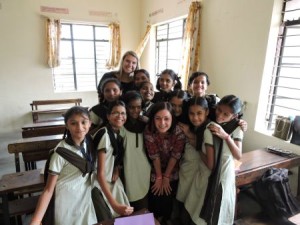In August, Colorado State University social work students and faculty traveled to Maharashtra, a state in central India, where they were profoundly affected by the people and sites they visited over the three-week trip.

They were hosted by the Center for Studies in Rural Development at Ahmednagar College for the first half of the trip, visiting nongovernmental organizations working on behalf of sex workers, orphans and homeless women with mental illness. They also visited the Comprehensive Rural Health Project in Jamked, a world-renowned public health model program, where they toured a working farm and heard stories of women’s lives transformed by health education.
The group spent the remaining time in the small town of Wai, running leadership groups for adolescent girls and volunteering in the classrooms of rural schools to promote English language skills. In addition the group visited the Ellora Caves: Buddhist, Jain and Hindu structures carved out of stone, dating from the 5th century and a Unesco World Heritage Site. They finished the trip in Mumbai, where a local guide toured them through the Dharavi slum, followed by a sampling of street food in the famous Chor Bazaar, a Muslim section of Mumbai.
Shannon Hughes, assistant professor in the School of Social Work, has led student trips to India for the past four years.
“The humility you gain from not knowing and constantly being challenged to form a reasonable opinion on the problems facing a very different culture opens you up to bringing the same humility to problems in your own backyard,” she said. “Every social problem is complicated by many layers of history, social traditions, interpersonal dynamics, political and economic interests, geopolitical conflicts, and competition for power and resources. The more I do in India, the more I see how fantastically rich, complex, and frustrating the analysis of social problems and their solutions can be. This year’s trip was no exception, as we witnessed just how many different worldviews from people of varying caste and class backgrounds exist in a single shared space.”
Arathi Seshadri, assistant professor in the Department of Soil and Crop Sciences at CSU, was traveling in India and met the group in Ahmednagar, where she gave a lecture on honeybees to an audience of close to 200 faculty and students of Ahmednagar College.
CSU social work seniors met with Indian graduate students studying social work at Ahmednagar College and had rich discussions on marriage and family, women’s rights, the caste system, and other pressing issues in India. Kristy Beachy-Quick, a research associate with CSU’s Social Work Research Center, accompanied the students and shared her evaluation work on parenting and child development programs with the social work faculty at Ahmednagar College.
It was senior Alice Ardito’s first time in India.
“You can get lectured to for hours and you can only absorb so much,” she said. “But to be here, seeing it, talking to people, and asking your own questions, that’s totally different. Meeting villagers and being able to see their everyday lives, where they grew up, walking through the village, and meeting their families, it’s so personalized. That’s what was amazing.”
Frannie Sovcik and Kenzie Bohm, both CSU seniors in social work, were returning to India after having participated in the service-learning trip last summer with Hughes. Sovicik, who is interested in educational equality, said, “Comparing the trip to last year’s, I walked away feeling more at ease with the fact that I’m never going to know everything. It was a good reminder that you have to have an open mind and humility when you travel to such a different culture.”
Beachy-Quick elaborated on the importance of humility.
“We see a two-room hut in a village with a cow dung floor and we immediately associate it with poverty and suffering,” she said. “But the woman who took us through her village grew up there and remembered it with such fondness. Ten or 12 people would sleep in a single room on straw mats on the floor, but the memories and stories we heard of growing up like that were filled with nostalgia and warmth, not suffering. It’s such a different way of being in the world, it’s communal, with lots of people, with hand-made small structures.”
Social work senior Bohm, who is minoring in international development at CSU, added, “Can you imagine Americans living in as small an area and space as Indians? We wouldn’t be functioning nearly as well as they are. Their sense of community is so strong.”
During a tour of the largest slum in Mumbai, which houses nearly 1 million people in only 0.67 square miles, Ardito observed, “Even in the slums, everything the people use is recycled and, sure, their living conditions aren’t ideal, but it is a functioning community and prosperous in its own way.”
The Dharavi slum has an estimated 5,000 businesses and 15,000 single-room factories.
Bohm expressed the success of the trip from her own perspective.
“We’ve always wanted to travel; it didn’t matter where, but I knew I didn’t want to just be a tourist,” she said. “I wanted to learn about a culture, and that’s exactly what we did.”
See more photos from the trip on the College of Health and Human Sciences Flickr site.